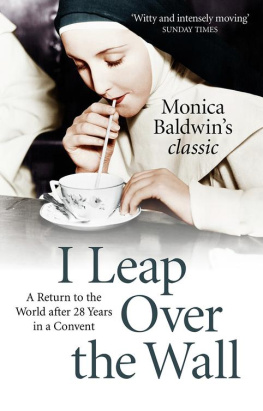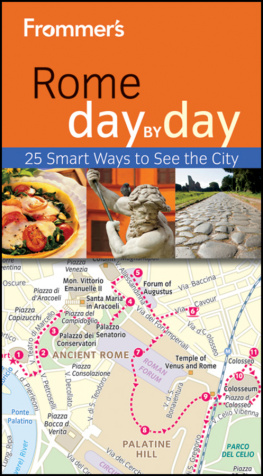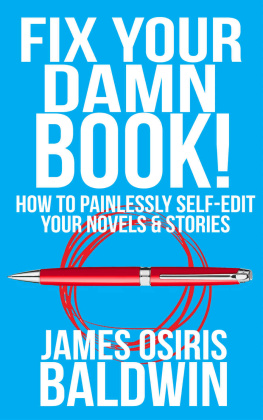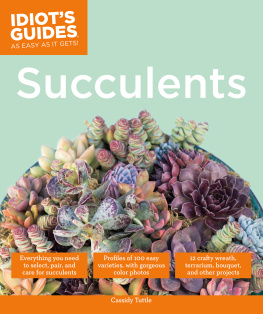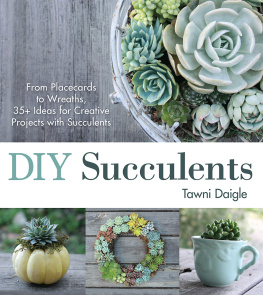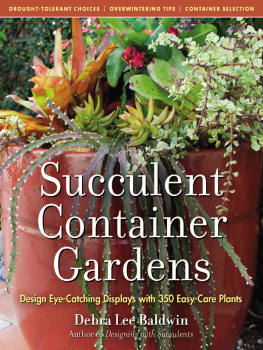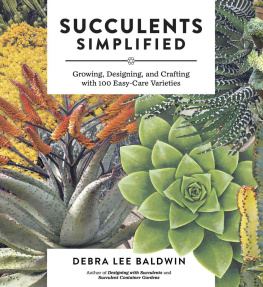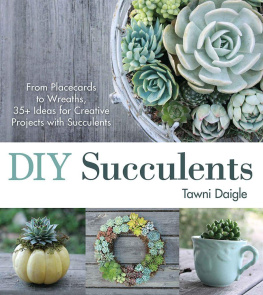Designing with Succulents

Debra Lee Baldwin
DESIGNING WITH
Succulents


Frontispiece: Succulents of assorted sizes and textures combine to create a lush, drought-tolerant garden. In the foreground, yellow fruit ring the crowns of barrel cacti. Behind them are orange-flowered aloes and Beaucarnea recurvata trees. Rancho Santa Fe, CA
All photographs are by Debra Lee Baldwin unless otherwise credited.
Copyright 2007 by Debra Lee Baldwin. All rights reserved.
Mention of trademark, proprietary product, or vendor does not constitute a guarantee or warranty of the product by the publisher or authors and does not imply its approval to the exclusion of other products or vendors.
Published in 2007 by
Timber Press, Inc.
The Haseltine Building
133 S.W. Second Avenue, Suite 450
Portland, Oregon 97204-3527, U.S.A.
www.timberpress.com
For contact information regarding editorial, marketing, sales, and distribution in the United Kingdom, see www.timberpress.co.uk.
Printed in China
Library of Congress Cataloging-in-Publication Data
Baldwin, Debra Lee, 1952
Designing with succulents / Debra Lee Baldwin.
p. cm.
Includes bibliographical references and index.
ISBN-13: 978-0-88192-816-7
1. Succulent plants. 2. Gardens--Design. 3. Gardening. I. Title.
SB438.B25 2007
635.9525--dc22
2006032039
A catalog record for this book is also available from the British Library.
To Jeff, Art, and Sandra
Contents
Acknowledgments
More than 150 homeowners, landscape designers, and plant experts made this book possible, and I am indebted to all of them. Individuals who were especially generous with their time and expertise include horticulturists Patrick Anderson and Joe Clements (former curator of the desert collection at the Huntington Botanical Gardens). Nursery owners Jeff Moore of Solana Succulents and Michael Buckner of The Plant Man contributed photos and helped fine-tune plant identification and descriptions. Other plant pros who were invaluable include Molly Thongthiraj of California Cactus Center, Jerry Hunter and Kelly Griffin of Rancho Soledad Nursery, kalanchoe and crassula expert Jeff Harris of the San Diego Cactus and Succulent Society, Margee Rader of Euro-American Propagators, Bill Teague of Quail Botanical Gardens, and echeveria expert Marylyn Henderson. I also am grateful to my editor at Sunset magazine, Kathleen Brenzel, whose idea it was in the first place that I write a book about designing with succulents, and who suggested Timber Press.
Preface
Succulent describes any plant that survives drought by storing water in its leaves, stems, or roots. When I was a child, such smooth, plump plants reminded me of modeling clay, and their shapes of stars, beads, and jelly beans. As I grew older, I equated succulents with jade plants that thrive in abandoned gardens and were removed by people who were serious about landscaping.
Succulents were far from my mind when I began gardening in 1990. Because I wanted big, bold, beautiful flowers, I cultivated tropical cannas, and my roses and fluffy perennials hearkened to English gardensnever mind that inland Southern California (USDA zone 9) is subject to frost, 100-degree heat, rain that falls minimally (and mostly in February), and the soil is decomposed granite, poor in organic matter. At one time I had more than a dozen varieties of cannas and 75 rosebushes, all of which required endless amending, mulching, fertilizing, pruning, spraying, irrigating, and deadheading. I still would be doing all that if my work had not introduced me to people who view gardening as an endeavor that ought to suit the region.
My job as a garden and design writer is to define and describe beauty. Whether I am touring a showcase house or a notable garden, I strive to find what makes the environment appealing. Architects, landscapers, and homeowners who design such settings dissect them for me, so my readers can learn their secrets.
In midwinter of 1999, when my garden consisted of pruned, leafless rosebushes; brown-leaved cannas; and perennials that had been cut to the ground, I was asked to write a story about Patrick Andersons garden, located in Fallbrook, California, midway between Los Angeles and San Diego. That day in December his garden was lush and colorful, despite its decomposed granite soil and lack of automatic irrigation.
Fleshy green monsters in Patrick Andersons Fallbrook garden look like they might snap him up if he turns his back, my article began. Theyre giant succulents, and Andersons half-acre hillside showcases hundreds of unusual ones. The story went on to describe aloes that pierce the sky like exotic torchbearers, hot orange against cool blue, and agaves that sprawl like squids, or explode upward like fistfuls of knives.
I discovered that succulents are as elegant as they are dramatic and show to advantage in uncomplicated combinations. Two or three varieties carefully selected for shape, color, and texture create simple, eye-catching compositions. Those succulentsnotably agaveswith curved or undulating leaves suggest motion, which makes any garden more intriguing. Moreover, like seashells and snowflakes, succulent foliage forms patterns that illustrate natures innate geometry and that are striking when repeated.

Orange spires of Aloe vanbalenii contrast with yellow blooms of Euphorbia rigida. The palm in the foreground is Bismarckia nobilis. Design by owner Patrick Anderson
During the next few years, I incorporated more and more succulents into my garden. Like traditional pruned hedges, succulents lent structure to the overall design but were much more practical. They held their shapes year-round and kept the same leaves for years. I learned firsthand that in a warm, dry climate, a garden comprising succulents and similarly drought-tolerant perennials makes sense economically, aesthetically, and ecologically. It is lush and appealing, requires significantly less water and maintenance than roses and tropicals, and does not turn into naked sticks in winter.
Aeonium arboreum and A. haworthii, Agave americana Marginata, and Bulbine frutescens proved trouble-freeas did the aloes, sedums, senecios, kalanchoes, and graptopetalums that followed. These were readily propagated, and the results were so easy-care and appealing that my garden subsequently was featured in Sunset magazine and Better Homes & Gardens.
Since then, I have sought gardens throughout Southern California, and as far away as New York and Vancouver, that show succulents to advantage. This book is the result of my search; its purpose is to offer alternatives to traditional lawn-and-flowerbed landscapes and to show what is possible when succulents shine as primary garden elements. It is a guide to aesthetic and practical ways to cultivate, display, and enjoy these versatile plants, in the ground as well as in containers.
DIVERSITY OF SUCCULENT GARDENS
Gardens of succulents and plants with similar cultivation requirements fall into the category of xeriscape
Next page



